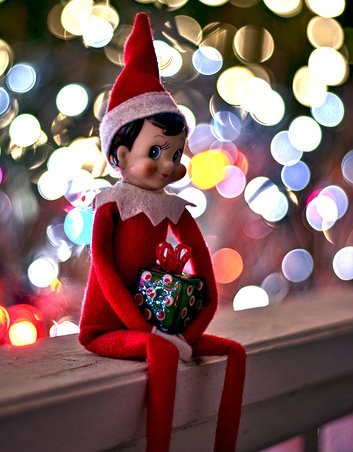No elf on our shelf

Like most American Christians, my family celebrates Christmas with a mix of Jesus and Santa Claus. Our stockings are hung by the fireplace; there’s a nativity set on top of the mantel. We sing “Rudolph” and “O Come, All Ye Faithful.” On Christmas Eve, we’ll go to church and read the Gospel of Luke, then come home and put out cookies for Santa.
Generally, I am okay with this. Children are remarkably able to hold on to more than one reality at a time. I trust mine to understand that this season contains more than one story.
But there is one story we don’t tell, one piece of secular Christmas that’s missing from our collection: there are no elves on our shelves.
The “Elf on the Shelf” narrative (based on a storybook and accompanying toy elf) goes something like this: The elf sits quietly on a shelf all day, observing, and then flies back to the North Pole every night to report to Santa on who has been naughty and who has been nice. The next morning, the children are sent to find the elf, who will resume his surveillance from a new spot. (Forgetful parents, take heart: sometimes the elf has a favorite place to sit and comes back to the very same spot he was in yesterday.)
The brand—“A Christmas Tradition”—has only been around since 2005. But marketing works. More than 2 million book-and-toy combinations have been sold. So pervasive is this new “tradition” that when a friend’s son visited and asked where our elf was, he didn’t quite believe me when I said we didn’t have one. He left convinced that we just hadn’t found our elf yet.
At the risk of sounding bah-humbug-y, I don’t like the Elf on the Shelf. General creepiness aside—someone in our house watches everything we do and reports back to the higher-ups? Aren’t there laws against this?—I find the idea particularly problematic for families trying to faithfully navigate the Christmas season.
For one thing, I am not willing to cede my parental authority to a toy, even one with magical powers. My husband and I are in charge around here; we get to judge what’s naughty and nice, and to determine the consequences. Putting someone else in charge of discipline for a month is just plain confusing—and scaring people into good behavior has rarely turned out well.
And what will parents do come January, when the elf flies home for the rest of the year? Who will keep the children in line?
The tattle-tale elf leaves little room for redemption. Mischievous activity is reported to Santa, and that’s the end of it. There’s no role for repentance, making amends or healing relationships, and it’s not at all clear how many naughty acts gets you demoted from presents or how many nice one make up for this.
One evening, I was trying to do too many things at once and my daughter’s hands were getting into everything in the kitchen. I lost my patience and threatened her with a time out.
“I can’t have a time out!” she cried, looking at me with something like fear in her eyes. “Santa won’t bring me anything!”
The words were forming themselves on my tongue: Then stop touching everything! But I couldn’t bring myself to say it.
Undeserved grace is the foundation of that other Christmas story we tell around here, the one with the baby and the manger. There’s no amount of niceness that earns us the gift of God-with-us, no level of naughty that the mercy of God can’t redeem.
I believe in grace too much to let Christmas be reduced to a month-long disciplinary tactic. Yes, my daughter needs to learn to keep her hands to herself, to stop taunting her baby brother, to hang up her jacket instead of leaving it on the floor. She won’t receive every toy she asks for this year, but it won’t be her behavior that dictates what she gets. The point of Christmas—at least the version I believe in—is not that we behave well. It’s that we’re not always all that nice, and God sends us the greatest gift anyway.





